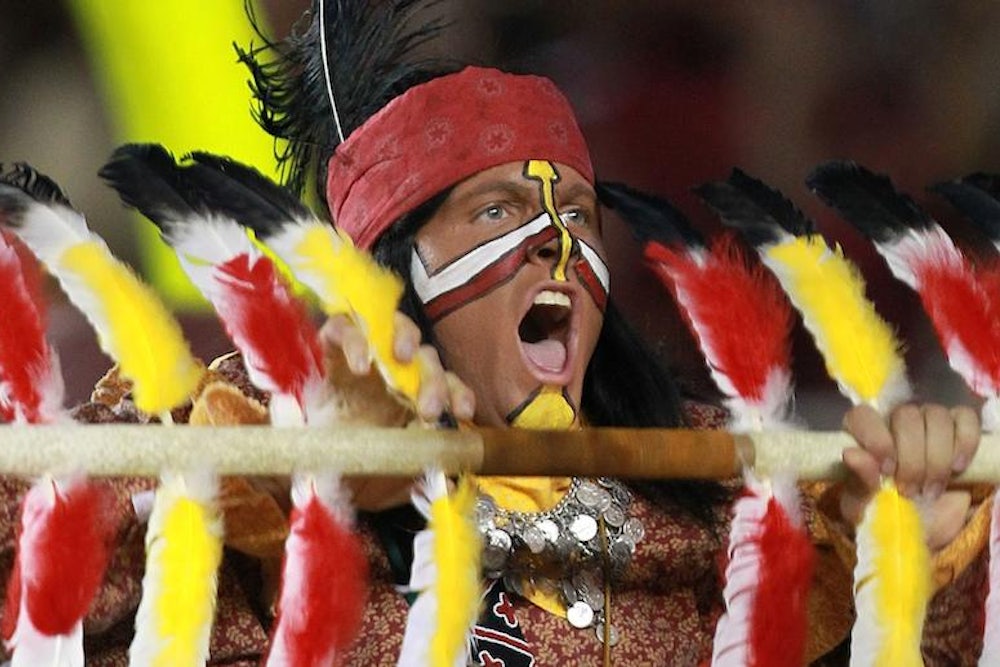“Like devoted fans of the Atlanta Braves, the Cleveland Indians and the Chicago Blackhawks (from President Obama's home town),” said Lanny Davis, speaking officially for Washington, D.C.’s football team, “we love our team and its name and, like those fans, we do not intend to disparage or disrespect a racial or ethnic group.” He inadvertently made a completely different point, though: It makes little sense for fans to focus exclusively on changing the Washington team’s name. As Davis accidentally noted, there are other awful ones, too, and—with apologies to Maureen Dowd’s big sister—they should also change their names.
In some instances (like Washington), the name is accompanied by an equally offensive logo. In others, teams have attempted to neuter negative associations. But this isn’t an argument for letting the lesser offenders slide. Rather, recognizing the different ways teams exploit Native American culture lets us appreciate the problem with doing it at all. Most of the names, explains Ned Blackhawk, a Yale professor who specializes in Native American history and law, “come out of a period largely in the mid-twentieth century when the federal government was in the process of assimilating or ‘terminating’ the tribes. They reflect a larger governmental and racial atmosphere in America that did not see these tribes as constituents in the future of the republic.”
Here's a subjective taxonomy—roughly ranked from the least to most offensive—of how professional and Division I teams exploit Native American culture in ways that wouldn’t be deemed acceptable if done to any other culture with that history of oppression.
WEAR YOUR JERSEY WITH PRIDE
Seattle Seahawks (NFL): The great logo, depicting the bird for which the team is named, is respectfully derived from totem poles indigenous to the Pacific Northwest. Oregon-based Nike took these motifs into account when redesigning the uniform last year.
St. John’s Red Storm (Division I): The Redmen (mascot: Chief Blackjack) changed their name to the Red Storm (mascot: Johnny the Thunderbird) in 1994. Similarly, back in the 1970s Stanford changed from the Indians to the Cardinal (the color, not the bird!).
Iowa Hawkeyes (Division I): The name originally derives from James Fenimore Cooper’s Delaware Indian character, but has been applied to Iowans for more than 150 years. Their only mascot has been Herky the Hawk.
Golden State Warriors (NBA): You may not realize it, but the name began as a Native American reference. The first logo was Sambo-esque; the second was a headdress. Since 1971, however, Warriors logos have alluded to the team’s Bay Area location, and a secondary logo, with its bolt of lightning, suggests an ancient mythical figure.
Illinois Fighting Illini (Division I): A close call—the Illini were a group of tribes, but it is not clear whether the name originated as a reference to Native Americans. In 2007, they dropped mascot Chief Illiniwek (who did not date as far back as the name itself).
“I HAVE MANY NATIVE AMERICAN FRIENDS”
Central Michigan Chippewas, University of Utah Utes and Florida State Seminoles (Division I): These three Division I teams are named after Native American tribes indigenous to their regions, and have received those tribes’ official permission. Does that really mean we shouldn’t care? FSU’s mascots Osceola and Renegade do not help matters, and nor do the feathers on the Utes logo.
YOU'VE CHANGED YOUR MASCOT. NOW CHANGE YOUR NAME.
William & Mary Tribe, Alcorn State Braves, and Bradley Braves (Division I): After a 2005 NCAA ruling banning Native American mascots in postseason play, several Division I schools ditched everything Native American except their names. The term “braves,” according to Professor Blackhawk, derives from Native American scouts who served alongside U.S. cavalry troops. A respectful tribute? Not really, says Professor Blackhawk: It’s still “a one-dimensional representation of people” that plays right into a stereotype, even if it is ostensibly a positive one.
Atlanta Braves (MLB): The team jettisoned mascot Chief Noc-A-Homa, who used to reside in a teepee in the bleachers, but fans have shown no sign of ceasing the Tomahawk Chop, which actually originated with FSU. Also, the logo!
SORRY, MR. PRESIDENT
Chicago Blackhawks (NHL). The logo is almost an exact mirror image of the Washington football team’s. The lone defense is that the team is named after not Native Americans but the World War One-era U.S. Army division “The Black Hawks,” which in turn took its name from a Sauk Indian chief.
SHAME ON YOU
Kansas City Chiefs (NFL): At least the name refers to an honorific. But the logo contains an arrowhead, they play at Arrowhead Stadium, and their horse is named “Warpaint.”
San Diego State University Aztecs (Division I): Mascot Zuma has been retired, but the team retains an arrowhead in its logo. The fight song mentions Montezuma, and other traditions reference the Mexican tribes.
Washington Football Team (NFL): Addressed here.
Cleveland Indians (MLB): Interestingly, mascot Chief Wahoo is not too prominently displayed on the team’s official website. You can, however, see him on their players’ standard hats.
So why do I rank the Indians as the worst? The name of the Washington team is by no means a term of honor, or even a neutral descriptor; it's a slur. But somebody could at least come to it without knowing its history and not understand how problematic it is. By contrast, there is nothing in the world of sports quite like Chief Wahoo, who at the first glance is revealed to be a demeaning and racist caricature. It does not get more racist than this:
